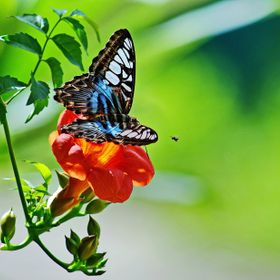Looking for nectar from a closed flower.
Looking for nectar from a closed flower.
Read less
Read less
Views
289
Likes
Awards
Fall Award 2020
Peer Award
Top Choice
Absolute Masterpiece
Magnificent Capture
Virtuoso
Superb Composition
Categories
Same photographer See allBehind The Lens
Discover more photos See all
Behind The Lens
Location
I took this photo in Chonburi, Pattaya, Thailand about one mile from the Gulf of Thailand.Time
When it comes to photographing butterflies, forget the "golden hours" of dawn and dusk. At least where I live, the butterflies are most active midday between 10 a.m. and 3 p.m. From my observations (not scientific, and I didn't read this anywhere), I believe the heat of midday may help the flowers give off their nectar, plus the birds are all napping. Supposedly birds don't eat butterflies, and some butterflies are even poisonous to birds, but I have twice witnessed a bird catch a butterfly for dinner. I've also noticed butterflies landing on leaves around 4 p.m. to sleep until the next day. They try to find a safe place where they are least noticeable with their wings folded.Lighting
There is also a photographic benefit to taking butterfly photos during midday. The bright overhead sun brings out their beautiful colors. This can be captured in two ways. Direct sunlight on the wings or sometimes, if you can shoot from a low angle, you can catch the sunlight shining through their wings. Either way, it brings out their deep, beautiful colors.Equipment
My camera is a Nikon D500. I will sometimes use my Nikkor 200-500 mm zoom, but more often, I'll use my Nikkor 18-300 mm zoom so I can get up close and personal. I also like to try and capture (photographically) a butterfly in flight, and the smaller lens is much better for that. I never use a tripod. Butterflies are too erratic in their flight and often move from flower to flower rather quickly, so a tripod would hinder and cause a lot of missed shots.Inspiration
I love the challenge of taking good butterfly photos. There are three that appeal to me most. A butterfly with its wings fully extended flat out, showing all its colors, a butterfly giving me a profile shot, preferably on a flower like this shot, and capturing a butterfly in flight. In this photo, this Burmese Raven butterfly intrigued me because it is on an unopened flower bud, and to me, it appears to be wondering how it can get any nectar out of it.Editing
If I get the shot right, which is easy to do with the bright midday light (other than white butterflies that tend to overexpose), I don't have to do much processing. First, I will crop. Then I always correct for camera noise. I might adjust the contrast if necessary, maybe just with dehaze, and sometimes I'll use a little sharpening or clarity. But I want the photo to look natural and not surreal, so I perform the minimum of editing as possible.In my camera bag
I usually only carry my camera and the lens combination for a nature photo shoot. I might have both my 18-300 mm zoom and my 200-500 mm zoom nearby if I want to switch lenses. But generally, I only carry my camera and the attached lens.Feedback
I live in the tropics where the sun comes up about 6 a.m. and sets around 6 p.m. Year-round. For butterflies, I shoot midday, so I wear a hat. This not only protects me from the sun; it is easier to see the butterflies without the sun's glare in my eyes. Although I'm a rather large presence invading their space, I find they pay less attention to me when I wear a camouflage shirt. I've discovered that butterflies tend to prefer the small wildflowers over the large decorative garden flowers, so look for a patch of wildflowers for a better chance of success. Since it is around midday, you may need to stop down your camera setting to prevent overexposure. I usually have my camera at 2000th of a second so I can quickly attempt to capture them in flight when they take off, but sometimes a butterfly will be slow and spend a lot of time on each flower, so I'll reduce my shutter speed down to around 500th of a second. Best of all, have patience and have fun. Trying to photograph a butterfly in flight is about the same as trying to stand a cooked piece of spaghetti on end. And exercise in frustration, but very rewarding when you get a good one.













































